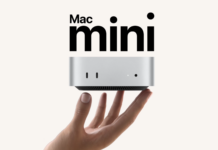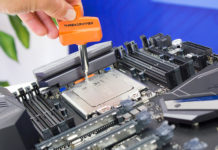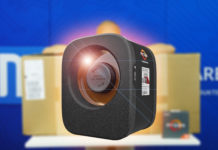Intel has now expanded its Core 2 Duo series with a new entry model; Core 2 Duo 4300. We test and investigate where this model fits with and how much bang for the buck it offers. The focus is on what seems to be its greatest advantage, namely overclocking.
The Intel Core 2 Duo series took the world by storm when launched 8 months ago. Since then the competition, AMD, hasn’t had much to put up against it. Core 2 Duo has also become the choice for overclockers and the performance records, with the top models X6800 and QX6700, have been a common sight in the news for the last months.

New 3DMark records and overclocking results at over 5 GHz are impressive and all, but for those who can’t afford to buy a processor for thousands of dollars, the cheaper models have a lot more appeal. Overclocking of a slower processor can save you a lot of money and gives everyone an opportunity to get real good performance at a low cost. Intel is launching a new model in its Core 2 Duo series now in January. NordicHardware now presents an overclocking preview of Intel’s Core 2 Duo E4300 based on the Allendale core.
E4300 is the new entry model of Intel’s Core 2 Duo series and it has ha few differences compared to earlier models. To start with it’s a whole new core which goes by the name of “Allendale”.
CPU comparison chart |
||||
| E4300 | E6300 | E6400 | E6600 | |
| Core | Allendale | Conroe | Conroe | Conroe |
| Frequency | 1800 MHz | 1862 MHz | 2128 MHz | 2394 MHz |
| FSB | 200 (800) MHz | 266 (1064) MHz | 266 (1064) MHz | 266 (1064) MHz |
| L2 cache | 2 MB | 2 MB | 2 MB | 4 MB |
| Multiple | 9x | 7x | 8x | 9x |
Allendale only has 2MB cache while the Conroe has 4MB. The present E6300 and E6400 also have 2MB cache and is often referred to as Allendale, this is wrong though. The core of the E6300 and E6400 is a Conroe, exactly as the other models. The difference is that half the cache has been deactivated. E4300 meanwhile is an authentic Allendale and only has 2MB cache. Another difference compared is that E4300 has a lower FSB and a higher multiple, not to forget the lack of Virtualization.
Visually there is no bigger difference between the CPUs. E6600 have a couple more components. E4300 Allendale to the left and E6600 Conroe on the right.
The Conroe models all have a 266 MHz FSB as standard while the Allendale only has a 200 MHz FSB. This forces Allendale to use a higher multiple and therefore you don’t have to reach insane the same high levels of FSB to reach high clock frequencies. Otherwise it’s the same technology as in Conroe and the cores are practically identical aside from half the cache.
We all know that Intel’s Core 2 Duo overclocks well. The question is how well. The benchmarks were performed outside of the case and at regular room temperature. We started off using Intel’s stock cooler, but we realized pretty soon that the processor became pretty hot and there fore switched to a Scythe Infinity, one of the best after market coolers around. With the stock cooler we used Intel’s pre-applied cooling paste and when switching to Scythe Infinity we used Arctic Silver 5.
 | ||
| Hardware | ||
| Motherboard | Asus P5B Deluxe (BIOS v0804) Intel P965 | **DFI Lanparty UT ICFX3200-T2R/G AMD/ATI RD600 |
| Processor | Intel Core 2 Duo E4300 | |
| Memory | 2x OCZ PC6400 800MHz ATI Crossfire certified (4-4-4-15) | |
| Graphics cards | MSI 7900GTO 512 MB | S3 Virge DX 4 MB PCI |
| Power supply | Antec EarthWatts 500W | |
| Software | ||
| Operating system | Windows XP (SP2) | |
| Graphics drivers | NVIDIA Forceware 91.47 WHQL | |
| Benchmarks | SiSoftware Sandra 2007 SuperPi mod v1.4 3DMark2001SE 3DMark2005 v1.2.0 3DMark2006 v1.0.2 WinRAR v3.61 Lame mp3 encoder Quake 4 v1.3 The Elder Scrolls 4 Oblivion v1.0.2.88 | |
** The motherboard was not present for the main portion of the test and was therefore only used to test the maximum frequency. More about this later.
Also worth mentioning:
* During the overclocking tests the memories were downclocked at bit so that they wouldn’t affect the results.
* All voltages mentioned are those set in BIOS. The actual voltage is slightly lower.
On paper everything looks fine. Most people who has overclocked Core 2 Duo knows that it’s usually not the processor that’s the problem, but the motherboard. Conroe has, by default, a high FSB and a low multiplier. Since the multiple is locked this means you have to reach a pretty high FSB to reach any decent clock frequencies. This usually results in the motherboard stopping any further overclocking and not the processor. If you end up with a bad motherboard you may not be able to overclock at all. This problem is less apparent with Allendale since it has a higher multiple and a lower FSB than equivalent Conroe. So, on paper things are looking mighty promising. There has been some information about the overclocking potential of the processor earlier on. People have been talking about 80% over the normal, which is hard to say no to.
First of all we wanted to check how high the processor would go. Pretty early we noticed that the system would boot at a certain frequency and did so working pretty stable. If you then increased the frequency of the FSB, a single step, the machine rebooted while loading Windows. After a lot of testing we managed to run SuperPi 1M at 3420 MHz, which is a 90% overclock. To reach this speed we had to use a voltage at 1,5V, which almost scorched the processor and the system turned off as soon as there was too much load, simply because the temperature rose above 80°C. We were convinced that the processor could do more with better cooling. We trashed Intel’s stock cooler and installed a Scythe Infinity. After that the temperatures became a lot more reasonable and we dared to use even higher voltage. At 1,6V we reach the top result at 3735 MHz, which is an overclock of mighty 107,5%. We should add that this sample is a so called “Engineering sample” and can therefore be a bit different from the final product.
To make sure the system wasn’t running nay hotter than necessary the first tests were performed with an old S3 Virge DX PCI graphics card. This was later on swapped for a MSI 7900 GTO while we also upgraded to a Scythe Infinity.
The maximum frequency is impressive, but a max frequency doesn’t really say that much. There is no point of having an overclocked computer if it’s not stable. The next step was to find the highest stable clock frequency. Therefore we sought out to find the highest frequency which could handle 3DMark. Surprisingly, we didn’t have to reduce the frequency that much to complete a round of 3DMark; 3663 MHz and two instances of 8M SuperPi passed at 3691 MHz. We should add that the system is not 100% stable at these frequencies, but enough to complete some benchmarking. Running the processor at 1,6V isn’t reasonable though, at least not without any more powerful cooling such as water or phase change. We set out to find the frequency where the processor was 100% stable and did not need much voltage. After some searching the optimal 24/7 sweetspot ended up at 3330 MHz at 1,45V and this is the frequency we’ve chosen to run the benchmarks to see how much performance you have to gain from overclocking the processor.
We also did some undervolting tests to see how low you can go, while keeping the frequency at the stock speed; 1800 MHz. This is interesting for those who want to build an HTPC or use passive cooling. At 1,1V, which is the lowest setting we could set, the system worked flawlessly. Since the motherboard can’t go any lower we can’t really answer how low you can go.
Last we tested how the processor react a higher voltage. We want back to the frequency the processor passed running dual instances at 8M SuperPi, at different voltages.
Even if you don’t have a great cooler you can easily overclock Allendale past 3GHz without even increasing the voltage.
*Update*
After we received DFI’s RD600 motherboard, we ran some tests with this motherboard as well. With the new motherboard we managed to push E4300 to 3780 MHz. This is a 110% overclocking, which is slightly higher than what Asus P5B Deluxe could do. As the temperature fell outside to below zero Celsius we managed to reach 3922 MHz; 117,88 %. This is the highest percentual overclock, using air cooling, achieved with a Core 2 Duo (as far as we know). Other than the motherboard the system was identical.
At room temperature E4300 reached 3780 MHz, but with some extra boost from the cool air outside the frequency rose to 3922 MHz. A 117,88 % overclock.
| Conclusion overclocking | |||
| Max. clock | 3735 MHz (3922 MHz) | 107,5 % (117,88 %) | 1,600 V (1,650 V) |
| Max. bench. clock: | 3663 MHz | 103,5 % | 1,600 V |
| Sweetspot | 3330 MHz | 85 % | 1,450 V |
| Max. clock at 1,325 V | 3204 MHz | 78 % | 1,325 V |
| 100 % stable at 1,325 V | 3069 MHz (3105 MHz) | 70,5 % (72,5 %) | 1,325 V |
The results in the parenthesis were achieved with a DFI Lanparty UT ICFX3200 T2R/G and the computer was standing out side in the cold. The CPU was running at about 25 °C.
SiSoft Sandra 2007:
First we ran some tests Sandra 2003 benchmarks to calculate the theoretical gain from the increased frequency.
The benchmarks show that the theoretic performance has almost been doubled. The difference will not be as large when running actual applications, but it shows that there is a lot to gain.
3DMark 2001:
Ol’ faithful got another turn to show how the score is affected by the higher frequency.
As expected, a significant increase.
3DMark 2005:
As you probably know 3DMark 05 doesn’t rely on the processor to the same degree as the tests have been designed to use the graphics card as much as possible. What makes this test interesting is that the stock frequency at 1800MHz, turns out to be a bottleneck for the graphics card and that the graphics card performs a lot better at the higher frequencies.
An improvement of almost 1300 points to that the graphics card likes the higher frequency. As expected.
3DMark 06
3DMark 06 has one (two really) dedicated processor tests we’re going to look into.
WinRar 3.6
SuperPi mod 1.4
Lame mp3 Encoder
We used a wave file (69min 40sec) and encoded it to mp3 with a variable bitrate at 192kbit/sec. The results are in seconds.
Quake 4 v1.3
The Elder Scrolls Oblivion
When we first saw the specifications for this processor we were wondering how this would fit with Intel’s assortment. E6300 has practically the same frequency and costs about the same as E4300. What makes E4300 more interesting than E6300 is the high multiple. I.e. you don’t have to buy a monster motherboard for a good overclock. If you’re not interested in overclocking E6300 is faster because of its higher FSB and a bit higher frequency.
At stock speed E4300 is faster than AMD X2 3800+ and they cost about the same. When you start overclocking E4300 AMD’s assortment is left far behind. You can reach, without much fuss, 3 GHz, which is even faster than Intel’s current top of the line model. The maximal frequency isn’t that unusual for a Core 2 Duo processor, but here you get this kind of performance for only $170, not bad. Our processor turned quite hot though. Even with a good cooler like Scythe Infinity, the temperature is higher than what we would call comfortable. Oddly, one core was about 5°C hotter than the other.
To conclude we have to say that Intel made a smart move by lowering the FSB and raising the frequency. This gives overclockers a bit more headroom and it becomes a lot simpler calculating the final frequency. The biggest problem with our sample was the heat. Even at pretty low voltages the temperature was higher than expected. If you have a better cooler this shouldn’t be a problem, but we can’t recommend anyone to run this processor with passive cooling. Despite that E4300 will most likely become the ”bang for the buck” of the season.
|
|
Intel Core 2 Duo E4300
|
|
Pros Cons |






























